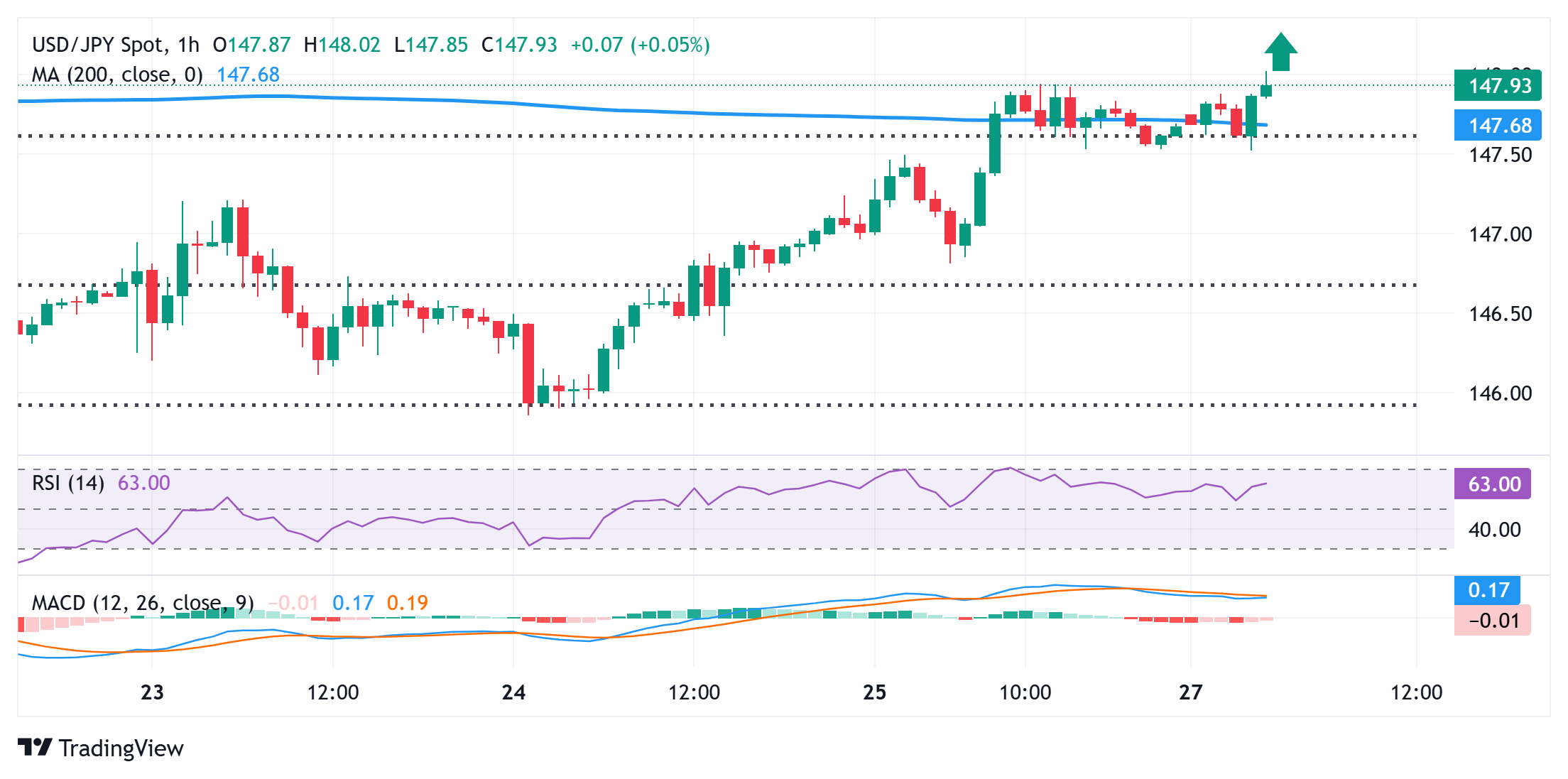Created
: 2025.07.28














![]() 2025.07.28 12:01
2025.07.28 12:01
The Japanese Yen (JPY) kicks off the new week on a softer note as the latest optimism over a trade deal between the US and the European Union (EU) undermines traditional safe-haven assets. Furthermore, reduced bets for an immediate interest rate hike by the Bank of Japan (BoJ), amid signs of cooling inflation in Japan and domestic political uncertainty, keep the JPY bulls on the defensive.
Meanwhile, Japan's trade deal with the US keeps the door open for an imminent BoJ rate hike this year, which, in turn, is seen acting as a tailwind for the JPY. This, along with subdued US Dollar (USD) price action, might keep a lid on any further gains for the USD/JPY pair. Traders might also refrain from placing aggressive directional bets and opt to wait for this week's key central bank events and data risks.
The US Federal Reserve (Fed) will announce its decision at the end of a two-day meeting on Wednesday, followed by the BoJ policy update on Thursday. Apart from this, US macro releases - the Advance Q2 GDP print, the Personal Consumption Expenditure (PCE) Price Index, and the Nonfarm Payrolls (NFP) report - will drive the US Dollar (USD) and provide a fresh impetus to the USD/JPY pair.

From a technical perspective, last week's bounce from the 50% retracement level of the July upswing and a subsequent strength beyond the 200-hour Simple Moving Average (SMA) could be seen as a key trigger for the USD/JPY bulls. This, along with positive oscillators on daily/hourly charts, suggests that the path of least resistance for spot prices is to the upside. A sustained move and acceptance above the 148.00 mark will reaffirm the constructive outlook, which, in turn, should pave the way for additional gains towards last week's swing high, around the 148.65 region. The momentum could extend further and allow the pair to make a fresh attempt towards conquering the 149.00 mark.
On the flip side, the 100-hour SMA, currently pegged around the 147.70-147.65 area, which now coincides with the 23.6% Fibo. retracement level could offer support to the USD/JPY pair. Any further slide could be seen as a buying opportunity near the 147.00 mark and remain limited near the 146.70-146.65 region, or the 38.2% Fibo. retracement level. Some follow-through selling below the 100-day SMA, currently pegged near the 146.55 area, could make spot prices vulnerable to retest sub-146.00 levels. This is closely followed by the 145.75 area (July 10 low), below which the currency pair could slide to the 145.20-145.15 region, or the 61.8% Fibo. retracement level, en route to the 145.00 psychological mark.
The Japanese Yen (JPY) is one of the world's most traded currencies. Its value is broadly determined by the performance of the Japanese economy, but more specifically by the Bank of Japan's policy, the differential between Japanese and US bond yields, or risk sentiment among traders, among other factors.
One of the Bank of Japan's mandates is currency control, so its moves are key for the Yen. The BoJ has directly intervened in currency markets sometimes, generally to lower the value of the Yen, although it refrains from doing it often due to political concerns of its main trading partners. The BoJ ultra-loose monetary policy between 2013 and 2024 caused the Yen to depreciate against its main currency peers due to an increasing policy divergence between the Bank of Japan and other main central banks. More recently, the gradually unwinding of this ultra-loose policy has given some support to the Yen.
Over the last decade, the BoJ's stance of sticking to ultra-loose monetary policy has led to a widening policy divergence with other central banks, particularly with the US Federal Reserve. This supported a widening of the differential between the 10-year US and Japanese bonds, which favored the US Dollar against the Japanese Yen. The BoJ decision in 2024 to gradually abandon the ultra-loose policy, coupled with interest-rate cuts in other major central banks, is narrowing this differential.
The Japanese Yen is often seen as a safe-haven investment. This means that in times of market stress, investors are more likely to put their money in the Japanese currency due to its supposed reliability and stability. Turbulent times are likely to strengthen the Yen's value against other currencies seen as more risky to invest in.
![]()
Created
: 2025.07.28
![]()
Last updated
: 2025.07.28

FXStreet is a forex information website, delivering market analysis and news articles 24/7.
It features a number of articles contributed by well-known analysts, in addition to the ones by its editorial team.
Founded in 2000 by Francesc Riverola, a Spanish economist, it has grown to become a world-renowned information website.
We hope you find this article useful. Any comments or suggestions will be greatly appreciated.
We are also looking for writers with extensive experience in forex and crypto to join us.
please contact us at [email protected].
Disclaimer:
All information and content provided on this website is provided for informational purposes only and is not intended to solicit any investment. Although all efforts are made in order to ensure that the information is correct, no guarantee is provided for the accuracy of any content on this website. Any decision made shall be the responsibility of the investor and Myforex does not take any responsibility whatsoever regarding the use of any information provided herein.
The content provided on this website belongs to Myforex and, where stated, the relevant licensors. All rights are reserved by Myforex and the relevant licensors, and no content of this website, whether in full or in part, shall be copied or displayed elsewhere without the explicit written permission of the relevant copyright holder. If you wish to use any part of the content provided on this website, please ensure that you contact Myforex.
Myforex uses cookies to improve the convenience and functionality of this website. This website may include cookies not only by us but also by third parties (advertisers, log analysts, etc.) for the purpose of tracking the activities of users. Cookie policy